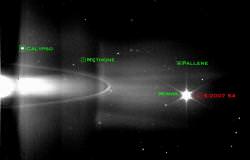Even in the smallest telescopes, Saturn’s bright rings pop into view. But those might be just the tip of the iceberg. During a recent flyby of the planet, NASA’s Cassini spacecraft noticed empty patches where the constant rain of high-energy electrons slowed down. Perhaps there are partial rings there, invisible to the spacecraft’s cameras. And where are these rings coming from?
When NASA’s Cassini spacecraft nears Saturn, its bombarded by a flurry of high energy electrons. But researchers from the Max Planck Institute for Solar System Research noticed that during the spacecraft’s journey, there were two times when it wasn’t being hit with so many particles. In their research article, published in the latest issue of the journal Icarus, they propose that there are invisible rings, generated by two of Saturn’s smallest moons: Methone and Anthe.
The gap in the rain of electrons occurred just as Cassini was passing through the orbits of Methone and Anthe. The drop in intensity lasted while the spacecraft covered a swath as wide as 1,000 to 3,000 km (600 to 1,900 miles) across. This is too wide for the tiny moons themselves, but arcs of ejected material could explain it.
“These observations tell us that even Saturn’s smallest moons could be a source of dust in the Saturnian system,” said Elias Roussos, the paper’s lead author from the Max Planck Institute for Solar System Research in Katlenburg-Lindau, Germany.
So, even the smallest moons around Saturn are feeding dust into the ring system. This released material may develop into partial ring arcs because of the gravitational “tug of war” between the planet’s larger moons, like Mimas. A situation like this has been found with Saturn’s G-ring.
Where’s all this material coming from? The researchers think that the constant rain of micrometeoroids on the surface of the tiny moons dislodges the icy material. Since they’re so small and have very little gravity, it doesn’t take much for the material to escape into space.
Strangely, these theorized rings are invisible. Meteoroids are thought to be generating the faint rings at Janus, Epimetheus and Pallene; but they’re visible to Cassini. The spacecraft can’t see these newly discovered rings with its cameras. Perhaps the two different classes of moons are releasing differently-sized grains of dust.
Original Source: NASA/JPL/SSI News Release

